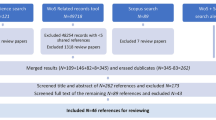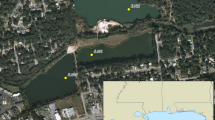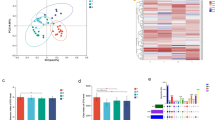Abstract
Next-generation DNA sequencing technology was applied to generate molecular data from semiarid reservoirs during well-defined seasons. Target sequences of 16S-23S rRNA ITS and cpcBA-IGS were used to reveal the taxonomic groups of cyanobacteria present in the samples, and genes coding for cyanotoxins such as microcystins (mcyE), saxitoxins (sxtA), and cylindrospermopsins (cyrJ) were investigated. The presence of saxitoxins in the environmental samples was evaluated using ELISA kit. Taxonomic analyses of high-throughput DNA sequencing data showed the dominance of the genus Microcystis in Mundaú reservoir. Furthermore, it was the most abundant genus in the dry season in Ingazeira reservoir. In the rainy season, 16S-23S rRNA ITS analysis revealed that Cylindrospermopsis raciborskii comprised 46.8% of the cyanobacterial community in Ingazeira reservoir, while the cpcBAIGS region revealed that C. raciborskii (31.8%) was the most abundant taxon followed by Sphaerospermopsis aphanizomenoides (17.3%) and Planktothrix zahidii (16.6%). Despite the presence of other potential toxin-producing genera, the detected sxtA gene belonged to C. raciborskii, while the mcyE gene belonged to Microcystis in both reservoirs. The detected mcyE gene had good correlation with MC content, while the amplification of the sxtA gene was related to the presence of STX. The cyrJ gene was not detected in these samples. Using DNA analyses, our results showed that the cyanobacterial composition of Mundaú reservoir was similar in successive dry seasons, and it varied between seasons in Ingazeira reservoir. In addition, our data suggest that some biases of analysis influenced the cyanobacterial communities seen in the NGS output of Ingazeira reservoir.
Similar content being viewed by others
References
Almeida, V.L.S., Dantas, E.W., Melo–Júnior, M., Bittencourt–Oliveira, M.C., and Moura, A.N. 2009. Zooplanktonic community of six reservoirs in northeast Brazil. Braz. J. Biol. 69, 57–65.
Altschul, S.F., Madden, T.L., Schäffer, A.A., Zhang, J., Zhang, Z., Miller, W., and Lipman, D.J. 1997. Gapped BLAST and PSIBLAST: a new generation of protein database search programs. Nucleic Acids Res. 25, 3389–3402.
Azevedo, S.M.F.O., Carmichael, W.W., Jochimsen, E.M., Rinehart, K.L., Lau, S., Shaw, G.R., and Eaglesham, G.K. 2002. Human intoxication by microcystin during renal dialysis treatment in Caruaru. Toxicology 181–182, 441–446.
Babica, P., Kohoutek, J., Bláha, L., Adamovsky, O., and Marsálek, B. 2006. Evaluation of extraction approaches linked to ELISA and HPLC for analyses of microcystin–LR,–RR and–YR in freshwater sediments with different organic material contents. Anal. Bioanal. Chem. 85, 1545–1551.
Ballot, A., Fastner, J., and Wiedner, C. 2010. Paralytic shellfish poisoning toxin–producing cyanobacterium Aphanizomenon gracile in northeast Germany. Appl. Environ. Microbiol. 76, 1173–1180.
Bittencourt–Oliveira, M.C. 2003. Detection of potentially microcystin producing cyanobacteria in Brazilian reservoirs with a mcyB molecular marker. Harmful Algae 2, 51–60.
Bittencourt–Oliveira, M.C., Piccin–Santos, V., Kujbida, P., and Moura, A.N. 2011a. Cylindrospermopsin in water supply reservoirs in Brazil determined by immunochemical and molecular methods. J. Water Resource Prot. 3, 349–355.
Bittencourt–Oliveira, M.C., Moura, A.N., Hereman, T.C., and Dantas, E.W. 2011b. Increase in straight and coiled Cylindrospermopsis raciborskii (cyanobacteria) populations under conditions of thermal de–stratification in a shallow tropical reservoir. J. Water Resource Prot. 3, 245–252.
Bittencourt–Oliveira, M.C., Dias, S.N., Moura, A.N., Cordeiro–Araújo, M.K., and Dantas, E.W. 2012a. Seasonal dynamics of cyanobacteria in a eutrophic reservoir (Arcoverde) in the semi–arid region of Brazil. Braz. J. Biol. 72, 533–544.
Bittencourt–Oliveira, M.C., Piccin–Santos, V., and Barros, S.G. 2012b. Microcystin–producing genotypes from cyanobacteria in Brazilian reservoirs. Environ. Toxicol. 27, 461–471.
Bittencourt–Oliveira, M.C., Piccin–Santos, V., Moura, A.N., Aragão–Tavares, N.K.C., and Cordeiro–Araújo, M.K. 2014. Cyanobacteria, microcystins and cylindrospermopsin in public drinking supply reservoirs of Brazil. An. Acad. Bras. Ciênc. 86, 297–310.
Bittencourt–Oliveira, M.C., Santos, D.M.S., and Moura, A.N. 2010. Toxic cyanobacteria in reservoirs in northeastern Brazil: detection using molecular method. Braz. J. Biol. 70, 1005–1010.
Bláhová, L., Oravec, M., Marsálek, B., Sejnohová, L., Simek, Z., and Bláha, L. 2009. The first occurrence of the cyanobacterial alkaloi toxin cylindrospermopsin in the Czech Republic as determined by immunochemical and LC/MS methods. Toxicon 53, 519–524.
Bolch, C.J.S., Blaekburn, S.I., Neilan, B.A., and Grewe, P.M. 1996. Genetic characterization of strains of cyanobacteria using PCRRFLP of the cpcBA intergenic spacer and flanking regions. J. Phycol. 32, 445–451.
Borges, H.L.F., Branco, L.H.Z., Martins, M.D., Lima, C.S., Barbosa, P.T., Lira, G.A.S.T., Bittencourt–Oliveira, M.C., and Molica, R.J.R. 2015. Cyanotoxin production and phylogeny of benthic cyanobacterial strains isolated from the northeast of Brazil. Harmful Algae 43, 46–57.
Bouvy, M., Falcão, D., Marinho, M., Pagano, M., and Moura, A. 2000. Occurrence of Cylindrospermopsis (cyanobacteria) in 39 Brazilian tropical reservoirs during the 1998 drought. Aquat. Microb. Ecol. 23, 13–27.
Bouvy, M., Molica, R., Oliveira, S., Marinho, M., and Beker, B. 2001. Effects of a cyanobacterial bloom (Cylindrospermopsis raciborskii) on bacterial and zooplankton communities in Ingazeira reservoir (Northeast, Brazil). Aquat. Microb. Ecol. 25, 215–227.
Bouvy, M., Nascimento, S.M., Molica, R.J.R., Ferreira, A., Huszar, V., and Azevedo, S.M.F.O. 2003. Limnological features in Tapacurá reservoir (northeast Brazil) during a severe drought. Hydrobiologia 493, 115–130.
Brazil. 2011. Ministry of Health. Regulation No. 2914, pp. 39–46. Brazilian official gazette, Executive Branch, Brasília, DF, Dec. 12, 2011. Section 1.
Brooks, J.P., Edwards, D.J., Harwich, M.D.Jr., Rivera, M.C., Fettweis, J.M., Serrano, M.G., Reris, R.A., Sheth, N.U., Huang, B., Girerd, P., et al. 2015. The truth about metagenomics: quantifying and counteracting bias in 16S rRNA studies. BMC Microbiol. 15, 66.
Chellappa, N.T. and Costa, M.A.M. 2003. Dominant and co–existing species of cyanobacteria from a eutrophicated reservoir of Rio Grande do Norte State, Brazil. Acta Oecol. 24, S3–S10.
Chevreux, B., Pfisterer, T., Drescher, B., Driesel, A.J., Müller, W.E., Wetter, T., and Suhai, S. 2004. Using the miraEST assembler for reliable and automated mRNA transcript assembly and SNP detection in sequenced ESTs. Genome Res. 14, 1147–1159.
Christiansen, G., Fastner, J., Erhard, M., Börner, T., and Dittmann, E. 2003. Microcystin biosynthesis in Planktothrix: genes, evolution, and manipulation. J. Bacteriol. 185, 564–572.
Costa, I.A.S., Azevedo, S.M.F.O., Senna, P.A.C., Bernardo, R.R., Costa, S.M., and Chellappa, N.T. 2006. Occurrence of toxinproducing cyanobacteria blooms in a Brazilian semiarid reservoir. Braz. J. Biol. 66, 211–219.
D’Agostino, P.M., Woodhouse, J.N., Katharina Makower, A., Yeung, A.C.Y., Ongley, S.E., Micallef, M.L., Moffitt, M.C., and Neilan, B.A. 2016. Advances in genomics, transcriptomics and proteomics of toxin–producing cyanobacteria. Environ. Microbiol. Rep. 8, 3–13.
Dantas, E.W., Bittencourt–Oliveira, M.C., and Moura, A.N. 2012. Dynamics of phytoplankton associations in three reservoirs in northeastern Brazil assessed using Reynolds’ theory. Limnologica 42, 72–80.
Dantas, E.W., Moura, A.N., and Bittencourt–Oliveira, M.C. 2011. Cyanobacterial blooms in stratified and destratified eutrophic reservoirs in semi–arid region of Brazil. An. Acad. Bras. Cienc. 83, 1327–1338.
Dittmann, E., Fewer, D.P., and Neilan, B.A. 2013. Cyanobacterial toxins: biosynthetic routes and evolutionary roots. FEMS Microbiol. Rev. 37, 23–43.
Dutilh, B.E., Schmieder, R., Nulton, J., Felts, B., Salamon, P., Edwards, R.A., and Mokili, J.L. 2012. Reference–independent comparative metagenomics using cross–assembly: crAss. Bioinformatics 28, 3225–3231.
Fonseca, J.R., Vieira, P.C.S., Kujbida, P., and da Costa, I.A.S. 2015. Cyanobacterial occurrence and detection of microcystins and saxitoxins in reservoirs of the Brazilian semi–arid. Acta Limnol. Bras. 27, 78–92.
Harke, M.J., Steffen, M.M., Gobler, C.J., Otten, T.G., Wilhelm, S.W., Wood, S.A., and Paerl, H.W. 2016. A review of the global ecology, genomics, and biogeography of the toxic cyanobacterium, Microcystis spp. Harmful Algae 54, 4–20.
Janse, I., Meima, M., Edwin, W., Kardinaal, A., and Zwart, G. 2003. High–resolution differentiation of cyanobacteria by using rRNAinternal transcribed spacer denaturing gradient gel electrophoresis. Appl. Environ. Microbiol. 69, 6634–6643.
Jochimsen, E.M., Carmichael, W.W., An, J., Cardo, D.M., Cookson, S.T., Holmes, C.E., Antunes, B.C., Melo Filho, D.A., Lyra, T.M., Barreto, V.S.T., et al. 1998. Liver failure and death after exposure to microcystins at a hemodialysis center in Brazil. N. Engl. J. Med. 338, 873–878.
Kellmann, R., Mihali, T.K., Jeon, Y.J., Pickford, R., Pomati, F., and Neilan, B.A. 2008. Biosynthetic intermediate analysis and functional homology reveal a saxitoxin gene cluster in cyanobacteria. Appl. Environ. Microbiol. 74, 4044–4053.
Kim, M., Lee, K.H., Yoon, S.W., Kim, B.S., Chun, J., and Yi, H. 2013. Analytical tools and databases for metagenomics in the nextgeneration sequencing era. Genomics Inform. 11, 102–113.
Lagier, J.C., Million, M., Hugon, P., Armougom, F., and Raoult, D. 2012. Human gut microbiota: Repertoire and variations. Front. Cell. Infect. Microbiol. 2, 136.
Lagos, N., Onodera, H., Zagatto, P.A., Andrinolo, D., Azevedo, S.M., and Oshima, Y. 1999. The first evidence of paralytic shellfish toxins in the water cyanobacterium Cylindrospermopsis raciborskii, isolated from Brazil. Toxicon 37, 1359–1373.
Li, N., Zhang, L., Li, F., Wang, Y., Zhu, Y., Kang, H., Wang, S., and Qin, S. 2011. Metagenome of microorganisms associated with the toxic cyanobacteria Microcystis aeruginosa analyzed using the 454 sequencing platform. Chinese J. Oceanol. Limnol. 29, 505–513.
Lira, G.A.S.T., Araújo, E.L., Bittencourt–Oliveira, M.C., and Moura, A.N. 2011. Phytoplankton abundance, dominance and coexistence in an eutrophic reservoir in the state of Pernambuco, Northeast Brazil. An. Acad. Bras. Cienc. 83, 1313–1326.
Lorenzi, A.S., Chia, M.A., Piccin–Santos, V., and Bittencourt–Oliveira, M.C. 2015. Microcystins and cylindrospermopsins molecular markers for the detection of toxic cyanobacteria: a case study of northeastern Brazilian reservoirs. Limnetica 34, 269–282.
Lorenzi, A.S., Cordeiro Araujo, M.K., Chia, M.A., and Bittencourt–Oliveira, M.C. 2018. Cyanotoxin contamination of semiarid drinking water supply reservoirs. Environ. Earth Sci. 77, 595.
Metcalf, J.S., Bell, S.G., and Codd, G.A. 2000. Production of novel polyclonal antibodies against the cyanobacterial toxin microcystin–LR and their application for the detection and quantification of microcystins and nodularin. Water Res. 34, 2761–2769.
Meyer, F., Paarmann, D., D’Souza, M., Olson, R., Glass, E.M., Kubal, M., Paczian, T., Rodriguez, A., Stevens, R., Wilke, A., et al. 2008. The metagenomics RAST server–a public resource for the automatic phylogenetic and functional analysis of metagenomes. BMC Bioinformatics 9, 386.
Mihali, T.K., Kellmann, R., Muenchhoff, J., Barrow, K.D., and Neilan, B.A. 2008. Characterization of the gene cluster responsible for cylindrospermopsin biosynthesis. Appl. Environ. Microbiol. 74, 716–722.
Molica, R.J.R., Oliveira, E.J.A., Carvalho, P.V.V.C., Costa, A.N.S.F., Cunha, M.C.C., Melo, G.L., and Azevedo, S.M.F.O. 2005. Occurrence of saxitoxins and an anatoxin–a(s)–like anticholinesterase in a Brazilian drinking water supply. Harmful Algae 4, 743–753.
Moura, A.N., Dantas, E.W., Oliveira, H.S.B., and Bittencourt–Oliveira, M.C. 2011. Vertical and temporal dynamics of cyanobacteria in the Carpina potable water reservoir in Northeastern Brazilian. J. Biol. 71, 451–459.
Moura, A.N., Nascimento, E.C., and Dantas, Ê.W. 2012. Temporal and spatial dynamics of phytoplankton near farm fish in eutrophic reservoir in Pernambuco, Brazil. Rev. Biol. Trop. 60, 581–597.
Neilan, B.A., Jacobs, D., and Goodman, A.E. 1995. Genetic diversity and phylogeny of toxic cyanobacteria determined by DNA polymorphisms within the phycocyanin locus. Appl. Environ. Microbiol. 61, 3875–3883.
Neilan, B.A., Pearson, L.A., Muenchhoff, J., Moffitt, M.C., and Dittmann, E. 2013. Environmental conditions that influence toxin biosynthesis in cyanobacteria. Environ. Microbiol. 15, 1239–1253.
Otsuka, S., Suda, S., Li, R., Watanabe, M., Oyaizu, H., Matsumoto, S., and Watanabe, M.M. 1998. 16S rDNA sequences and phylogenetic analysis of Microcystis strains with and without phycoerythrin. FEMS Microbiol. Lett. 164, 119–124.
Otsuka, S., Suda, S., Shibata, S., Oyaizu, H., Matsumoto, S., and Watanabe, M.M. 2001. A proposal for the unification of five species of the cyanobacterial genus Microcystis Kützing ex Lemmermann 1907 under the rules of the bacteriological code. Int. J. Syst. Evol. Microbiol. 51, 873–879.
Parks, D.H., Tyson, G.W., Hugenholtz, P., and Beiko, R.G. 2014. STAMP: Statistical analysis of taxonomic and functional profiles. Bioinformatics 30, 3123–3124.
Penn, K., Wang, J., Fernando, S.C., and Thompson, J.R. 2014. Secondary metabolite gene expression and interplay of bacterial functions in a tropical freshwater cyanobacterial bloom. ISME J. 8, 1866–1878.
R Development Core Team. 2015. R: A language and environment for statistical computing. R foundation for statistical computing, Vienna, Austria. URL https://www.R–project.org/.
Rantala, A., Fewer, D.P., Hisbergues, M., Rouhiainen, L., Vaitomaa, J., Börner, T., and Sivonen, K. 2004. Phylogenetic evidence for the early evolution of microcystin synthesis. Proc. Natl. Acad. Sci. USA 101, 568–573.
Rastogi, R.P., Madamwar, D., and Incharoensakdi, A. 2015. Bloom dynamics of cyanobacteria and their toxins: environmental health impacts and mitigation strategies. Front. Microbiol. 6, 1254.
Rogers, S.O. and Bendich, A.J. 1985. Extraction of DNA from milligram amounts of fresh, herbarium, and mummified plant tissues. Plant Mol. Biol. 5, 69–76.
Rouhiainen, L., Vakkilainen, T., Siemer, B.L., Buikema, W., Haselkorn, R., and Sivonen, K. 2004. Genes coding for hepatotoxic heptapeptides (Microcystins) in the cyanobacterium Anabaena strain 90. Appl. Environ. Microbiol. 70, 686–692.
Rudi, K., Skulberg, O.M., Larsen, F., and Jakobsen, K.S. 1997. Strain characterisation and classification of oxyphotobacteria in clone cultures on the basis of 16S rRNA sequences from variable regions V6, V7 and V8. Appl. Environ. Microbiol. 63, 2593–2599.
Sant’Anna, C.L., Azevedo, M.T.P., Senna, P.A.C., Komárek, J., and Komárková, J. 2004. Planktic cyanobacteria from São Paulo State, Brazil: Chroococcales. Rev. Bras. Bot. 27, 213–227.
Sipos, R., Székely, A.J., Palatinszky, M., Révész, S., Márialigeti, K., and Nikolausz, M. 2007. Effect of primer mismatch, annealing temperature and PCR cycle number on 16S rRNA gene–targeting bacterial community analysis. FEMS Microbiol. Ecol. 60, 341–350.
Smith, F.M.J., Wood, S.A., van Ginkel, R., Broady, P.A., and Gaw, S. 2011. First report of saxitoxin production by a species of the freshwater benthic cyanobacterium, Scytonema Agardh. Toxicon 57, 566–573.
SRH (Secretaria de Recursos Hídricos de Pernambuco). 2000. Plano Estadual de Recursos Hídricos do Estado de Pernambuco–Documento Síntese, Recife.
Steffen, M.M., Belisle, B.S., Watson, S.B., Boyer, G.L., Bourbonniere, R.A., and Wilhelm, S.W. 2015. Metatranscriptomic evidence for co–occurring top–down and bottom–up controls on toxic cyanobacterial communities. Appl. Environ. Microbiol. 81, 3268–3276.
Steffen, M.M., Li, Z., Effler, T.C., Hauser, L.J., Boyer, G.L., and Wilhelm, S.W. 2012. Comparative metagenomics of toxic freshwater cyanobacteria bloom communities on two continents. PLoS One 7, e44002.
Strunecký, O., Elster, J., and Komárek, J. 2011. Taxonomic revision of the freshwater cyanobacterium Phormidium murrayi = Wilmottia murrayi. Fottea 11, 57–71.
Tillett, D., Dittmann, E., Erhard, M., von Döhren, H., Börner, T., and Neilan, B.A. 2000. Structural organization of microcystin biosynthesis in Microcystis aeruginosa PCC7806: an integrated peptide–polyketide synthetase system. Chem. Biol. 7, 753–764.
Voorhies, A.A., Eisenlord, S.D., Marcus, D.N., Duhaime, M.B., Biddanda, B.A., Cavalcoli, J.D., and Dick, G.J. 2016. Ecological and genetic interactions between cyanobacteria and viruses in a low–oxygen mat community inferred through metagenomics and metatranscriptomics. Environ. Microbiol. 18, 358–371.
Walter, J.M., Lopes, F.A.C., Lopes–Ferreira, M., Vidal, L.M., Leomil, L., Melo, F., de Azevedo, G.S., Oliveira, R.M.S., Medeiros, A.J., Melo, A.S.O., et al. 2018. Occurrence of harmful cyanobacteria in drinking water from a severely drought–impacted semi–arid region. Front. Microbiol. 9, 176.
Willame, R., Boutte, C., Grubisic, S., Willmotte, A., Komárek, J., and Hoffmann, L. 2006. Morphological and molecular characterization of planktonic cyanobacteria from Belgium and Luxemburg. J. Phycol. 42, 1312–1332.
Wood, S.A., Mountfort, D., Selwood, A.I., Holland, P.T., Puddick, J., and Cary, S.C. 2008. Widespread distribution and identification of eight novel microcystins in antarctic cyanobacterial mats. Appl. Environ. Microbiol. 74, 7243–7251.
Woodhouse, J.N., Kinsela, A.S., Collins, R.N., Bowling, L.C., Honeyman, G.L., Holliday, J.K., and Neilan, B.A. 2016. Microbial communities reflect temporal changes in cyanobacterial composition in a shallow ephemeral freshwater lake. ISME J. 10, 1337–1351.
World Bank. 2013. Water resources planning and adaptation to climate variability and climate change in selected river Basins in Northeast Brazil. Final report on a non lending technical assistance program (P123869). World Bank, Washington DC, USA.
Zhang, J., Kobert, K., Flouri, T., and Stamatakis, A. 2013. PEAR: a fast and accurate Illumina Paired–End reAd mergeR. Bioinformatics 30, 614–620.
Author information
Authors and Affiliations
Corresponding author
Additional information
Supplemental material for this article may be found at http://www.springerlink.com/content/120956.
Electronic supplementary material
Rights and permissions
About this article
Cite this article
Lorenzi, A.S., Chia, M.A., Lopes, F.A.C. et al. Cyanobacterial biodiversity of semiarid public drinking water supply reservoirs assessed via next-generation DNA sequencing technology. J Microbiol. 57, 450–460 (2019). https://doi.org/10.1007/s12275-019-8349-7
Received:
Revised:
Accepted:
Published:
Issue Date:
DOI: https://doi.org/10.1007/s12275-019-8349-7




